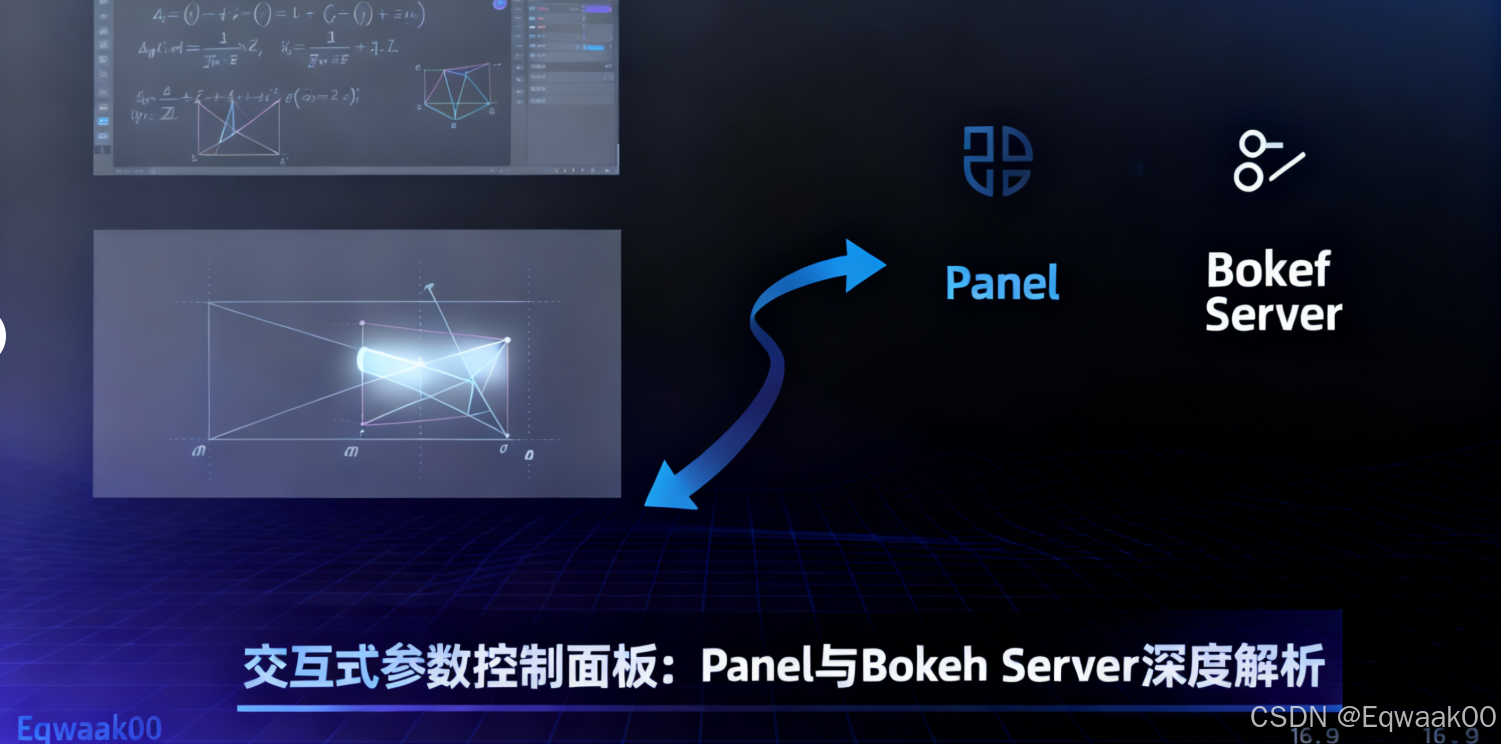交互式参数控制面板:Panel与Bokeh Server深度解析
一、交互式可视化的核心价值
在数据科学项目中,交互式参数控制是探索性分析(EDA)和模型调优的关键能力。传统静态图表无法满足动态调整需求,而交互式面板允许用户通过滑块、按钮等控件实时修改可视化参数,实现:
- 参数探索:如调整模型超参数观察结果变化
- 数据筛选:通过时间滑块查看历史数据趋势
- 多维度对比:切换不同变量组合分析关系
本指南将系统讲解两种主流方案:
- Panel:轻量级参数控制(基于HoloViz生态)
- Bokeh Server:全功能Web应用(适合复杂交互)
二、Panel:轻量级参数控制方案
2.1 核心优势
| 特性 | Panel | Bokeh Server |
|---|---|---|
| 学习曲线 | 简单(类似Jupyter Notebook) | 较高(需理解服务器架构) |
| 部署复杂度 | 低(单文件运行) | 中(需服务器配置) |
| 交互响应速度 | 快(本地计算) | 中(网络往返) |
| 适用场景 | 快速原型、数据分析 | 生产级Web应用、多用户访问 |
2.2 基础控件类型
2.2.1 滑块(Slider)
import panel as pn
import numpy as np
import matplotlib.pyplot as pltpn.extension(sizing_mode="stretch_width")# 创建滑块
amplitude_slider = pn.widgets.FloatSlider(name='振幅',start=0.1,end=5.0,value=1.0,step=0.1
)# 回调函数
def plot_sine(amplitude):x = np.linspace(0, 10, 100)y = amplitude * np.sin(x)plt.figure()plt.plot(x, y)plt.title(f'振幅={amplitude}')plt.show()# 绑定滑块与函数
sine_plot = pn.bind(plot_sine, amplitude=amplitude_slider)# 组合显示
pn.Row(amplitude_slider, sine_plot)2.2.2 按钮与下拉菜单
# 按钮控件
def on_button_click(event):print(f"按钮被点击!参数:{event.new}")button = pn.widgets.Button(name="执行分析", button_type="primary")
button.param.watch(on_button_click, "clicks")# 下拉菜单
dropdown = pn.widgets.Select(name='图表类型',options=['折线图', '散点图', '热力图'],value='折线图'
)# 组合显示
pn.Column(button, dropdown)2.3 高级交互:联动控制
# 多滑块联动
x_slider = pn.widgets.IntSlider(name='X偏移', start=0, end=10, value=0)
y_slider = pn.widgets.IntSlider(name='Y偏移', start=0, end=10, value=0)# 联动函数
def plot_shifted_sine(x_offset, y_offset):x = np.linspace(0, 10, 100)y = np.sin(x - x_offset) + y_offsetplt.figure()plt.plot(x, y)plt.title(f'X偏移={x_offset}, Y偏移={y_offset}')plt.show()# 绑定多个滑块
plot = pn.bind(plot_shifted_sine, x_offset=x_slider, y_offset=y_slider)# 组合显示
pn.Column(pn.Row(x_slider, y_slider),plot
)三、Bokeh Server:全功能Web应用
3.1 架构概览
Bokeh Server采用客户端-服务器架构:
- Bokeh Document:定义图表和控件
- Bokeh Server:处理用户交互并更新图表
- Bokeh Client:浏览器端渲染
3.2 基础控件与回调
3.2.1 滑块与实时更新
from bokeh.plotting import figure, show, curdoc
from bokeh.models import Slider, ColumnDataSource
from bokeh.layouts import column
import numpy as np# 初始化数据
source = ColumnDataSource(data=dict(x=[], y=[]))# 创建图表
plot = figure(title="实时正弦波", plot_height=300, plot_width=800)
line = plot.line('x', 'y', source=source, line_width=2)# 创建滑块
amplitude_slider = Slider(start=0.1, end=5.0, value=1.0, step=0.1, title="振幅")# 回调函数
def update_data(attr, old, new):amplitude = amplitude_slider.valuex = np.linspace(0, 10, 100)y = amplitude * np.sin(x)source.data = dict(x=x, y=y)# 绑定滑块
amplitude_slider.on_change('value', update_data)# 布局
layout = column(amplitude_slider, plot)
curdoc().add_root(layout)3.2.2 按钮与数据筛选
from bokeh.models import Button
from bokeh.layouts import row# 创建按钮
button = Button(label="随机生成数据", button_type="success")# 回调函数
def generate_data():x = np.random.random(100) * 10y = np.random.random(100) * 5source.data = dict(x=x, y=y)button.on_click(generate_data)# 组合布局
layout = row(amplitude_slider, button, plot)
curdoc().add_root(layout)3.3 高级交互:动态图表类型切换
from bokeh.models import Select# 下拉菜单
plot_type = Select(title="图表类型", value="line", options=["line", "scatter"])# 回调函数
def update_plot_type(attr, old, new):plot.renderers.clear()if new == "line":line = plot.line('x', 'y', source=source, line_width=2)else:scatter = plot.circle('x', 'y', source=source, size=5, color="red")plot_type.on_change('value', update_plot_type)# 完整布局
layout = column(row(amplitude_slider, button),plot_type,plot
)
curdoc().add_root(layout)四、性能优化技巧
4.1 Panel优化
| 问题 | 解决方案 |
|---|---|
| 控件响应卡顿 | 使用pn.bind而非回调函数,减少重复计算 |
| 大图表渲染慢 | 降低数据点数量(如x = np.linspace(0, 10, 100)改为x = np.linspace(0, 10, 50)) |
| 内存泄漏 | 在Jupyter Notebook中重启内核定期释放内存 |
示例:优化后的Panel代码
# 使用pn.bind减少重复计算
def plot_sine(amplitude):x = np.linspace(0, 10, 50) # 降低数据点y = amplitude * np.sin(x)return hv.Curve((x, y), 'X', 'Y')# 直接绑定
sine_plot = pn.bind(plot_sine, amplitude=amplitude_slider)4.2 Bokeh Server优化
| 问题 | 解决方案 |
|---|---|
| 服务器负载高 | 使用@curdoc.add_periodic_callback定期更新而非实时更新 |
| 网络延迟 | 启用bokeh.io.output_notebook()本地调试 |
| 内存占用大 | 使用ColumnDataSource的stream方法增量更新数据 |
示例:增量更新数据
# 初始化数据
source = ColumnDataSource(data=dict(x=[], y=[]))# 增量更新函数
def update_data():new_x = np.random.random(10) * 10new_y = np.random.random(10) * 5source.stream(dict(x=new_x, y=new_y), 100) # 保留最新100个点# 定期更新
curdoc().add_periodic_callback(update_data, 1000) # 每秒更新一次五、完整案例:交互式数据探索工具
5.1 需求描述
开发一个房价分析工具,支持:
- 通过滑块调整房屋面积和房间数
- 实时显示价格预测
- 切换不同回归模型
5.2 Panel实现
import panel as pn
import pandas as pd
import numpy as np
from sklearn.linear_model import LinearRegression
from sklearn.ensemble import RandomForestRegressorpn.extension(sizing_mode="stretch_width")# 模拟数据
np.random.seed(42)
data = pd.DataFrame({'Area': np.random.randint(50, 200, 100),'Rooms': np.random.randint(1, 6, 100),'Price': np.random.randint(100000, 500000, 100)
})# 初始化模型
models = {'线性回归': LinearRegression(),'随机森林': RandomForestRegressor()
}
model = models['线性回归']
model.fit(data[['Area', 'Rooms']], data['Price'])# 控件
area_slider = pn.widgets.IntSlider(name='面积', start=50, end=200, value=100)
rooms_slider = pn.widgets.IntSlider(name='房间数', start=1, end=5, value=2)
model_select = pn.widgets.Select(name='模型', options=list(models.keys()), value='线性回归')# 回调函数
def predict_price(area, rooms, model_name):model = models[model_name]if model_name == '线性回归' and not hasattr(model, 'coef_'):model.fit(data[['Area', 'Rooms']], data['Price'])elif model_name == '随机森林' and not hasattr(model, 'feature_importances_'):model.fit(data[['Area', 'Rooms']], data['Price'])prediction = model.predict([[area, rooms]])[0]return f"预测价格: ${prediction:,.0f}"# 绑定
price_display = pn.bind(predict_price, area=area_slider, rooms=rooms_slider, model_name=model_select)# 布局
pn.Column(pn.Row(area_slider, rooms_slider, model_select),price_display
)5.3 Bokeh Server实现
from bokeh.plotting import figure, show, curdoc
from bokeh.models import Slider, Select, ColumnDataSource, Div
from bokeh.layouts import column, row
from bokeh.io import output_notebook
import pandas as pd
import numpy as np
from sklearn.linear_model import LinearRegression
from sklearn.ensemble import RandomForestRegressor# 模拟数据
data = pd.DataFrame({'Area': np.random.randint(50, 200, 100),'Rooms': np.random.randint(1, 6, 100),'Price': np.random.randint(100000, 500000, 100)
})# 初始化模型
models = {'线性回归': LinearRegression(),'随机森林': RandomForestRegressor()
}
model = models['线性回归']
model.fit(data[['Area', 'Rooms']], data['Price'])# 创建图表
plot = figure(title="房价分布", plot_height=400, plot_width=800)
scatter = plot.circle('Area', 'Price', size=5, color="blue", source=ColumnDataSource(data))# 控件
area_slider = Slider(start=50, end=200, value=100, title="面积")
rooms_slider = Slider(start=1, end=5, value=2, title="房间数")
model_select = Select(value="线性回归", options=list(models.keys()), title="模型")# 预测显示
prediction_div = Div(text="预测价格: $0", style={'font-size': '16px'})# 回调函数
def update_prediction(attr, old, new):area = area_slider.valuerooms = rooms_slider.valuemodel_name = model_select.valuemodel = models[model_name]if model_name == '线性回归' and not hasattr(model, 'coef_'):model.fit(data[['Area', 'Rooms']], data['Price'])elif model_name == '随机森林' and not hasattr(model, 'feature_importances_'):model.fit(data[['Area', 'Rooms']], data['Price'])prediction = model.predict([[area, rooms]])[0]prediction_div.text = f"预测价格: ${prediction:,.0f}"# 绑定控件
area_slider.on_change('value', update_prediction)
rooms_slider.on_change('value', update_prediction)
model_select.on_change('value', update_prediction)# 布局
layout = column(row(area_slider, rooms_slider, model_select),prediction_div,plot
)
curdoc().add_root(layout)六、部署与扩展
6.1 Panel部署
6.1.1 本地运行
# 保存为app.py
panel serve app.py --show6.1.2 云端部署
# 使用Panel Cloud(需注册账号)
pn.serve(app, port=5006, show=True, autoreload=True)6.2 Bokeh Server部署
6.2.1 本地运行
# 保存为app.py
bokeh serve app.py --show6.2.2 Docker部署
dockerfile:
# Dockerfile
FROM python:3.9-slim
RUN pip install bokeh pandas scikit-learn
COPY . /app
WORKDIR /app
CMD ["bokeh", "serve", "app.py", "--port=5006"]6.2.3 生产环境配置
# app.py
from bokeh.server.server import Server
from bokeh.application import Application
from bokeh.application.handlers.function import FunctionHandlerdef modify_doc(doc):# 这里放Bokeh代码passserver = Server(Application(FunctionHandler(modify_doc)),port=5006,allow_websocket_origin=["*"] # 允许跨域
)
server.start()七、总结与选择指南
7.1 方案选择
| 场景 | 推荐方案 | 理由 |
|---|---|---|
| 快速原型开发 | Panel | 简单易用,本地运行 |
| 生产级Web应用 | Bokeh Server | 功能强大,支持多用户访问 |
| Jupyter Notebook调试 | Panel | 集成度高,无需服务器 |
| 大规模交互应用 | Bokeh Server | 性能优化,支持增量更新 |
7.2 最佳实践
-
Panel:
- 优先使用
pn.bind减少回调函数 - 在Jupyter中定期重启内核防止内存泄漏
- 使用
sizing_mode="stretch_width"响应式布局
- 优先使用
-
Bokeh Server:
- 使用
ColumnDataSource的stream方法更新数据 - 通过
@curdoc.add_periodic_callback控制更新频率 - 启用
allow_websocket_origin支持跨域访问
- 使用
通过交互式参数控制面板,数据科学家可以快速探索数据规律,提升分析效率和洞察深度。# 交互式参数控制面板:Panel与Bokeh Server深度解析

